
Well and equitably funded public schools allow for small student-to-teacher ratios, attracting and retaining high-quality teachers, and providing a range of supportive services from nurses to librarians.
All families should have access to high-quality education but because of longstanding systemic barriers, DC’s Black and brown students, especially those who live east of the Anacostia River, face deep and persistent disparities in childhood development and educational outcomes. While DC schools have made some progress in closing these disparities in recent years, the instability and loss caused by the pandemic only exacerbated preexisting inequities. By directing adequate resources to schools and implementing sound budgeting practices, the District can help ensure that all students have what they need to succeed.
This guide to public school funding in DC explains how the District funds its traditional public schools and public charter school districts, or local education agencies (LEAs), as well as how LEAs allocate funding to individual schools within their systems. Residents’ experiences can help inform policymakers’ school funding decisions. Look for the megaphone icon located throughout the guide for opportunities to use your voice to influence how DC policymakers and top education officials fund public schools.
Table of Contents
- Where does Funding for Schools Come From?
- The Uniform Per Student Funding Formula: DC’s Tool for Funding Public Schools
- How DCPS Funds Its Schools
- How Public Charter LEAs Fund Their Schools
- Appendix A: Relevant Public Education Agencies
- Appendix B: School Finance Resources
- Appendix C: Glossary
Where Does Funding For Schools Come From?
In DC, traditional public schools and public charter schools are funded through a combination of local, federal, private, grant, and other funding (Figures 1 and 2). In both sectors, more than 80 percent of the budget comes from local revenue sources such as taxes on personal income, business income, and property.
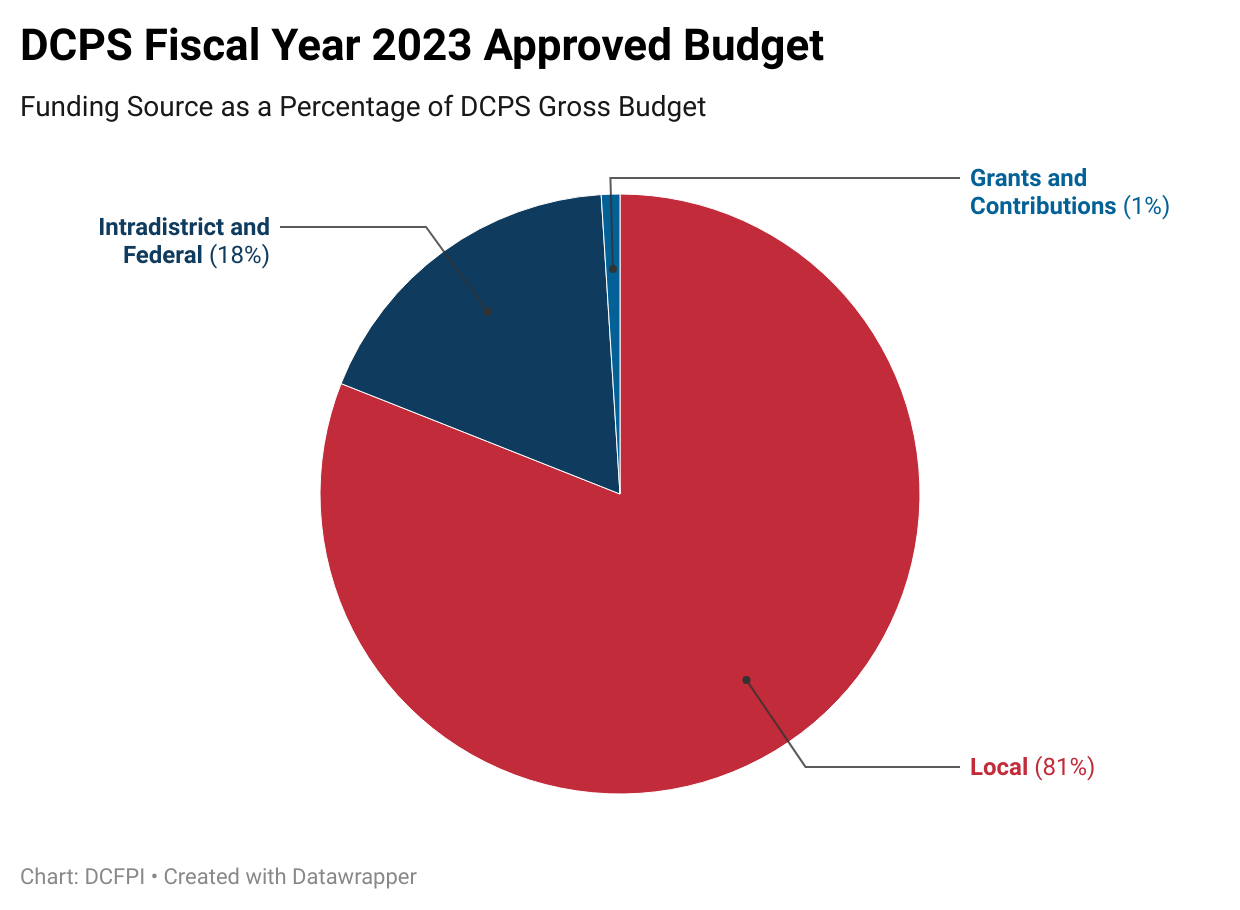
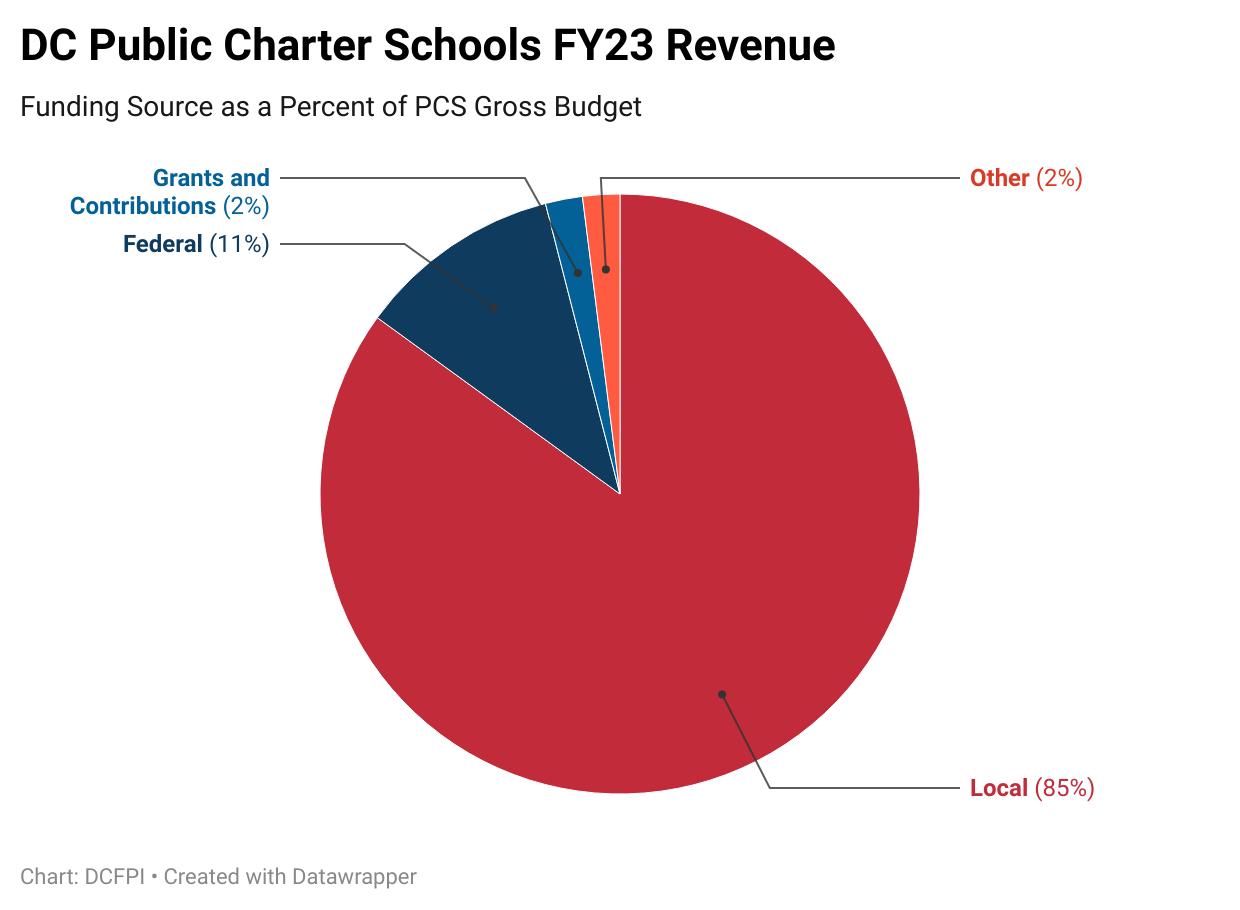
In most states, state and local governments share the responsibility for funding public school districts. State governments raise revenue for districts through state taxes, while most local governments raise revenue for schools primarily through property taxes. Often states provide a funding formula that ensures adequate funding per student no matter where they live, by adding onto, matching, or standardizing local funding of schools. The District differs from other states because its government carries out the functions of both a city and state and manages all the revenue streams that are drawn upon for the Uniform Per Student Funding Formula (UPSFF) that funds DC Public Schools (DCPS) and public charter LEAs (See section on the Uniform Per Student Funding Formula).
The Every Student Succeeds Act (ESSA), the federal law that governs kindergarten through 12th grade (K-12) public education policy in the US, provides the majority of federal funding to DCPS and public charter LEAs. ESSA provides grants to help state education agencies, such as DC’s Office of the State Superintendent of Education (OSSE), and LEAs to fund initiatives designed to support student achievement. Some of these programs target money to students from families with low incomes while other programs support professional development for school staff, services for English Language Learners, and out-of-school time enrichment. The federal government also provides funds to OSSE to support and protect the educational rights of students with disabilities and students experiencing homelessness. The federal government also typically provides temporary funding to states and localities during sharp economic downturns to help offset plummeting revenues, better ensuring that all students can continue to receive a decent public education during hard economic times.
Importantly, the federal government sets the rules for these programs and determines the appropriate funding levels. Neither the mayor nor the DC Council have authority over these funds.
What About Federal COVID-19 Recovery Dollars?
The US Department of Education provided an unprecedented level of federal investment in public education to assist states and LEAs in helping schools reopen safely and help students recover from the pandemic. The District received more than $600 million in three federal Elementary and Secondary School Emergency Relief grants (ESSER I, II, and III) (See Appendix C for descriptions of each federal grant). School closures and other disruptive changes contributed to declines in reading and math scores, both nationally and locally. This “learning loss” exacerbated the longstanding and unacceptable racial and income-based inequities in student outcomes, academic and otherwise. With Black and Latinx households having born the brunt of COVID cases and deaths in DC, schools continue to face even more challenges in narrowing learning and opportunity gaps.
The District has provided some information about how LEAs allocated and spent their ESSER funds, though there is still a lot of information that the public and policymakers do not know. The LEA ESSER Dashboard, created by OSSE, provides some visual information about how DCPS and public charter LEAs allocated their funds, but lacks important functions (such as allowing users to make comparisons by LEA, ward, or school type) and allocation and spending information at the school level. Additionally, the ESSER spending plan provided by OSSE provides high level information on how they have spent the set-aside funds.
Roughly $540 million of the total $600 million went directly to LEAs through formula grants while the remaining funds were set aside for scaling up the District’s literacy and math curriculum, supporting students with disabilities, and expanding out of school time and enrichment programming.
The American Rescue Plan Act (ARPA) of 2021 gave DC the largest package of ESSER funds, providing $386 million in ESSER III funds to help OSSE and LEAs safely reopen schools and make multi-year investments in academic and health supports for students. ARPA includes provisions to ensure the District does not supplant existing education spending with federal dollars and to protect schools with majority Black and brown students and students from families with low incomes. These rules set a historic precedent for school funding equity by explicitly requiring states and school districts to use fiscal recovery strategies that are not at the expense of low-income children’s educational futures.
ESSER I-III will be fully spent by September 30, 2024, yet the District still lacks a detailed picture of ESSER spending. More importantly, some data show that several schools in DCPS used these one-time dollars to fund needed, recurring staff positions. These schools will face potential “fiscal cliffs” in future budgets if DC policymakers and DCPS fail to set a long-term vision and roadmap to adequately and equitably fund schools once these one-time dollars are fully spent. The ESSER dashboard has been inconsistently and infrequently updated, which results in more uncertainty on how big the fiscal cliff, or gap between needs and funding, will be for schools across the District. However, because schools with higher populations of students “at-risk of academic failure” received more ESSER funding under the maintenance of equity requirements, it is likely that these schools will face the greatest challenges as ESSER dollars expire.
Operating Funds vs Capital Funds: What’s the Difference?
Operating funds are dollars that schools use to pay for day-to-day expenses, such as the salaries of teachers, principals, custodians, and other staff, school supplies, field trips, and more. Policymakers provide these funds through the DC Operating Budget.
Capital funds support projects like renovations for existing schools, new school building construction, repairs to broken windows or dilapidated playgrounds, upgrades to classroom technology infrastructure, and more. Policymakers fund these projects through the DC Capital Budget, which sets funding for projects through a six-year plan. Capital projects are often long-term and financed by the local government.
The District funds capital projects for DCPS and public charter schools differently, which is discussed later in this guide (See the sections on how DCPS and public charter LEAs fund their schools).
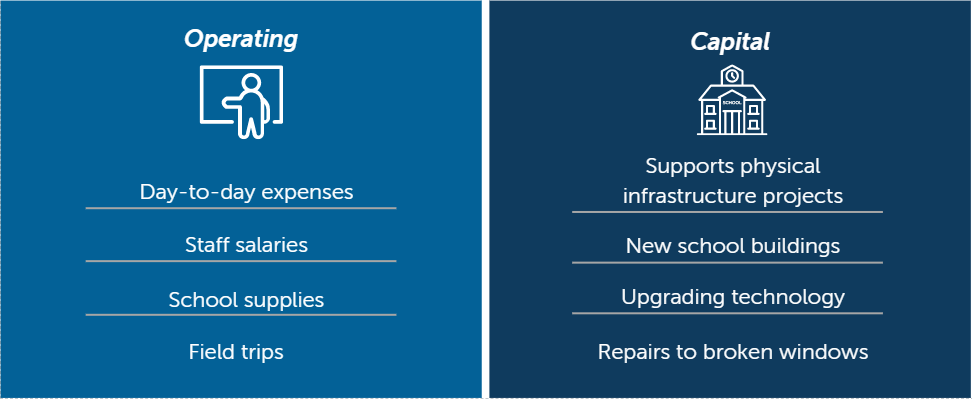
The Uniform Per Student Funding Formula: DC’s Tool for Funding Public Schools
DC funds all public schools through the Uniform Per Student Funding Formula (UPSFF), which allocates money for each student and with adjustments depending on their needs. The District established the UPSFF in 1996, following DC Council’s passing of a law that mandated the government fund traditional and public charter schools through the same funding formula. The formula only governs local operating dollars that the District allocates to DCPS and public charter schools, not federal or private funding nor capital costs.
The District provides funding to schools on a per student basis through the UPSFF. The formula is made up of several parts, including a foundation (or base weight) level and additional weights that adjust the base per-student funding based on factors like grade level, special needs students or those designated “at risk,” and English language learners (Figure 3). Each of these parts generate funding for DCPS and public charter LEAs.
- Foundation level: The foundation level is the per-student amount DC schools need to provide basic, general education services. It’s also sometimes referred to as the base weight.
- Grade-level weights: The foundation level is multiplied against grade-level weights to account for differences in educational resources that schools need to provide a general education to students at different grade levels.
- Supplemental weights based on student characteristics: The foundation level is multiplied against supplemental weights to account for the added costs of serving students who are designated “at risk” of academic failure, students with disabilities, and students who are English Language Learners. Students are designated “at risk” if their families receive food or income assistance through SNAP or TANF, experience homelessness, are in the foster care system, or exceed the typical age in high school.
- Other supplemental weights and add-ons: The UPSFF includes additional weights for residential public charter schools that provide room and board to students, residential special education public charter schools, DCPS special education schools, summer school for students receiving special education services, and special education compliance and attorney fees. The formula also includes a per-student facilities allotment for public charter LEAs to finance buildings, which is discussed later in this guide (See “How Public Charter LEAs Fund Their Schools”).

The mayor has the greatest influence over setting the UPSFF level (Figure 4). While both the mayor and DC Council may propose increases, decreases, or no changes to the formula, the mayor’s budget comes out first and the Council rarely makes substantial changes to the UPSFF proposal. The Deputy Mayor for Education (DME) is the mayor’s closest advisor on public education matters in DC. The DME oversees all public education agencies in the District and works closely with the mayor to develop proposed changes to the formula. The DCPS Chancellor, who is appointed by the mayor, has authority over setting individual DC Public School budgets, which is discussed later in this guide. Other public education agencies do not have any authority to adjust the UPSFF (See Appendix A for descriptions of relevant DC public education agencies).

 Use Your Voice to Influence the UPSFF!
Use Your Voice to Influence the UPSFF!
- Urge the mayor and DC Council to ensure annual adjustments to the UPSFF keep up with rising education costs and student needs.
- Write letters to, or schedule meetings with, the mayor and DC Councilmembers and/or their staff.
- Testify about the harms of inadequate UPSFF increases at DC Council hearings.
- Watch recordings of the UPSFF Working Group meetings.
A Bit of UPSFF History You Should Know
The first UPSFF foundation level was based on a “basket” of educational goods and services that DC government officials, education experts, and advocates identified as being necessary to providing a general education to all public school students. This basket was made up of nine categories of general education services (Figure 5).
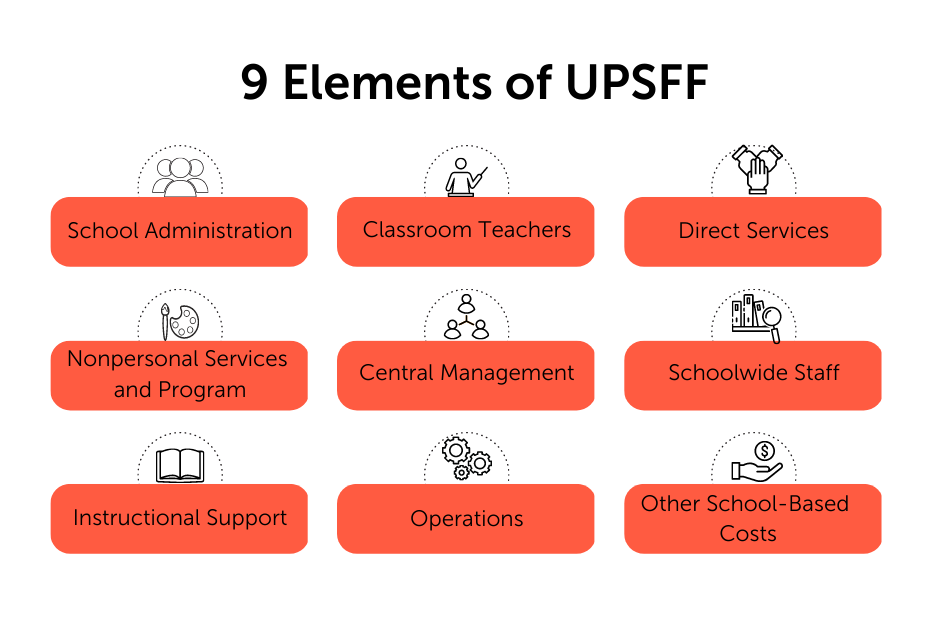
The District has not revised or updated this basket of goods since establishing the UPSFF. However, the DME has conducted two studies—one in 2013 and another in 2020—to assess whether the foundation level and supplemental weights are adequate for providing a quality education in DC. DC policymakers have never provided funding at the levels recommended in the 2013 Adequacy Study. More recently, the mayor implemented a few recommendations from the 2020-21 UPSFF Working Group, which OSSE is required to convene every two years. These recommendations included increasing funding for over-age high school students and splitting the English Language Learner (ELL) weight into two different weights to account for the different needs of elementary and secondary ELL students.
Due to a law adopted by the mayor and DC Council in the fiscal year (FY) 2023 budget process, the DME is additionally required to conduct an adequacy study every five years starting in 2023 and make recommendations for formula adjustments as needed.
Other Ways the District Supports Schools
The District provides resources to students and schools through other District agencies’ budgets. For example, the District funds school nurses through the Department of Health’s budget and funds crossing guards through the Department of Transportation’s budget. Other examples:
- The Department of General Services provides maintenance support to DCPS.
- The Office of the Chief Technology Officer provides some technology support services to DCPS.
- The Office of the Attorney General provides some legal services to DCPS, such as those stemming from a special education lawsuit or claim.
How DCPS Funds its Schools
The Schools First in Budgeting Act Aims to Stabilize School Budgets
On December 20, 2022, the DC Council approved a new law, the Schools First in Budgeting Amendment Act of 2021 (Schools First), that aims to protect individual DC public school budgets from year-to-year budget reductions. The law newly requires that DCPS fund schools at least at the level of their prior year budget, with some exceptions. Under this law DCPS also must make incremental increases to the budget to keep up with some, but not all, rising costs of educating students. Notably, it limits instances in which DCPS can reduce funding or full-time equivalent staff. This is in response to many schools routinely being forced to cut staff even when enrollment did not decline or declined by very few students. The Council passed an emergency version of the bill so that the changes could go into immediate effect.
However, during the 2024 fiscal year, DCPS failed to comply with Schools First, which has resulted in many unknowns. Chancellor Ferebee has stated that DCPS will work to comply with the new legislation in the next budget season. DC Council as well as DCPS have held budget hearings to align on the funding model going forward, but there is still no clear answer as to what implementation of this law will look like or when it will be fully executed. Education advocates are concerned that individual school budgets may continue to face cuts if the Chancellor fails to comply with the law.
DCPS is the District’s traditional public system, the largest LEA, and serves students in 116 schools. The District provides all local, operating funds to DCPS through the UPSFF. To determine the school system’s UPSFF funding, the DME projects DCPS’s enrollment by grade level and student characteristics for the coming year. Once the DME finalizes its projections, the enrollment numbers are multiplied by the UPSFF foundation level, grade-level weights, and supplemental weights to generate DCPS’s local fund budget. The District then allocates this funding to DCPS, and the agency uses a separate funding model to calculate initial, or projected, budgets for individual schools (Figure 6).
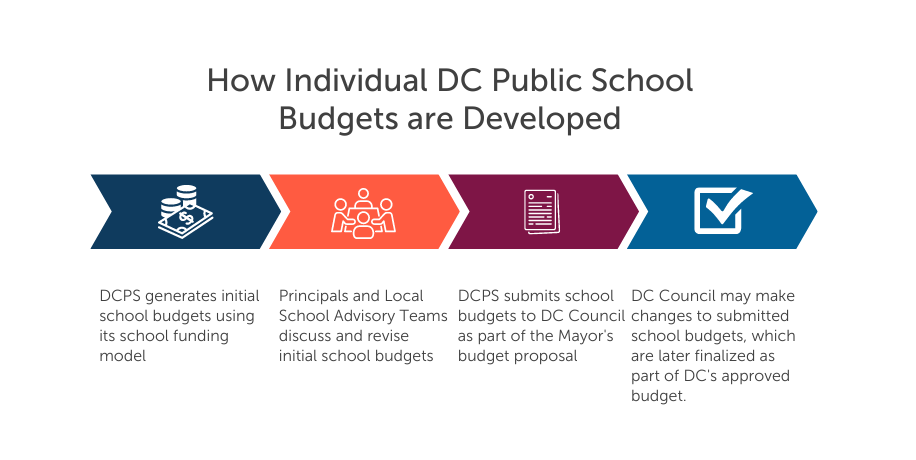
The DCPS Chancellor is responsible for allocating UPSFF funding. Most of that funding goes directly to schools and the rest goes to support the agency’s central office, which carries out two core functions: centralized operational tasks to run the school system and school supports that are budgeted outside of individual school budgets (Table 1). The way in which DCPS categorizes expenses in central office and school supports has long been the subject of public oversight and budget debates. Some Councilmembers and advocates have raised concerns that the DCPS both spends too much on what it categorizes as central office functions and also substantially understates the size of the central office budget by categorizing central office staff as school support.
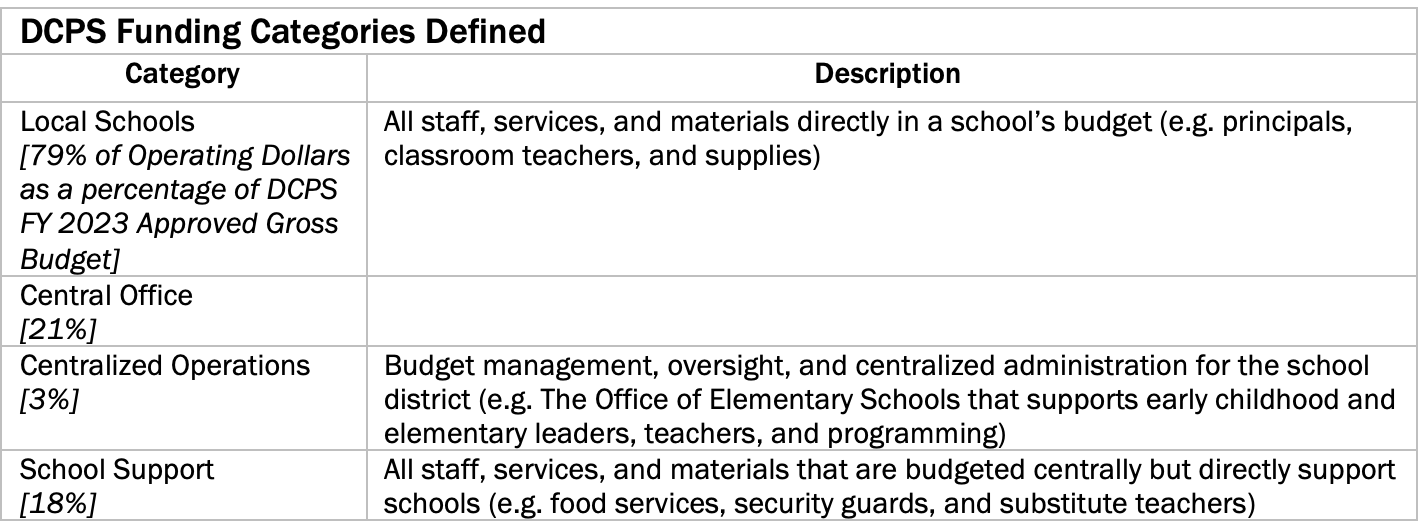
Once DCPS develops the initial school budgets, it sends those budgets to schools and the principal and Local School Advisory Teams (LSAT)—groups of elected and appointed members (teachers, school staff, parents, community members, and sometimes even students) that advise the principal on school improvement plans, budget proposals, and other important matters. Principals and LSATs have a short window to discuss and revise their budgets based on their school’s needs. While the mayor considers LSAT’s proposals in her proposed budget that she submits to DC Council, typically in March, the timeline is tight and there is no guarantee that the feedback will be incorporated. Similarly, DC Council may make increases or other changes to schools’ budgets based on the feedback they receive from educators and families. Otherwise, school budgets are approved by the Council and later signed into law or vetoed by the mayor as a part of the overall budget process.
DC Public Schools Budget Timeline
This is the general timeline in which DCPS develops individual school budgets, but timing may vary.November: DCPS hosts a public hearing on budgets for upcoming fiscal year.
Nov-January: DCPS submits agency budget request to mayor and works with mayor’s team to develop initial school budgets.
Early-to-mid February: DCPS publishes initial school budgets to its website, and the mayor may announce proposed increases to the UPSFF ahead of DCPS making school budgets public.
Late-February: Principals and LSATs typically have ten school days to discuss and revise initial budgets.
Early March: Schools submit budgets to DCPS. DCPS may approve or deny proposed changes (including requests for additional funding or reallocation of resources).
Early-to-mid March: DCPS budgets are included in the proposed budget that the mayor submits to the DC Council and are referred to as “submitted budgets.”
It is also important to note that although the school year (SY) starts in August and ends in June, DC’s fiscal year runs from October 1-September 30. This results in a single school year spanning across two different fiscal years. For example, the first weeks of SY23-24 fall under the FY23 budget, but most of the school year (October – June) is a part of the FY24 budget.
 Use Your Voice to Influence the Overall Budget Process for DCPS!
Use Your Voice to Influence the Overall Budget Process for DCPS!
- Join your school’s LSAT or get involved with the DC LSAT Collective.
- Attend your ward education council meetings.
- Become familiar with the DCPS budget process, timeline, and model.
- Request meetings with Councilmembers or their staff.
- Testify about budget needs at DCPS and DC Council public hearings.
- Organize walkarounds at the John A. Wilson Building to drop in on Councilmembers or their staff.
- Flag concerns at relevant DC State Board of Education hearings.
The DCPS Budget Model Explained
DCPS funds each of its schools using a school funding model, which it updated in SY 2022-23. The three primary goals of this updated model are to increase transparency, equity, and provide year-over-year funding stability, according to DCPS. The funding model is new and should be rigorously evaluated by DCPS and policymakers to determine if it meets its intended goals; the evaluation should include engagement with school staff and families to include their perspectives.
Policymakers designed the updated model to give principals LSATs more discretion over spending decisions. The new model reduces the number of positions that schools are required to have, moving away from the former Comprehensive Staffing Model that allocated funding to schools based on enrollment and staffing requirements. The updated model combines:
- A student-based budgeting (SBB) formula,
- Limited staff-based allocations,
- Program grants, and
- Stability funding.
Together, these parts generate an individual school’s budget. Each part of the model is explained below. To understand the model, it is important to note how DCPS categorizes the funding that it provides to schools. Each category relates to different parts of the model.
- Enrollment-based funds: Money that is based on the projected student enrollment for the upcoming school year and makes up most of the funding that DCPS allocates to schools. This funding covers staff positions and some non-personnel services (NPS).
- Targeted support funds: Money that schools must use to provide additional supports to specific populations, such as students designated “at-risk of academic failure” (“at-risk”) ELL students, and students receiving special education services. This funding also includes funding for education campuses—where grades K-8 are served in one building—and early learning centers for PK3 & 4 students. Supplemental federal grant funding that some schools qualify for is included in this category as well.
- Stability funding: Money that DCPS provides to stabilize school budgets as schools experience enrollment fluctuations. By law, DCPS is required to give schools at least 95 percent of their previous year’s budget. Due to the pandemic’s outsized negative effect on student enrollment (particularly in the early grades), DCPS provided additional stability funding beyond what is required by the law in SY 2022-23.
DCPS Uses Salary Averages to Build School Budgets
DCPS builds individual school budgets using an average teacher salary that includes a base salary, benefits, performance-based pay, and bonuses. The average teacher salary also includes costs of substitute teachers and fingerprinting and drug testing—functions that are one-time and/or managed centrally, yet annually charged to individual schools.
While salary information is key to recruit and retain high quality educators, residents should note that publicly available information about school budgets do not distinguish between salaries, bonuses, and other charges associated with teacher costs.
Student-Based Budgeting Drives Enrollment-Based Funds
DCPS determines schools’ enrollment-based funding primarily through a SBB formula that allocates dollars to schools based on the number of projected students, where students are funded through a base weight and additional supplemental weights based on student and school characteristics (Table 2). Note that the SBB formula also generates some of the targeted support funding for schools, with the remainder of targeted support funding coming from program grants discussed in sub-sections below.
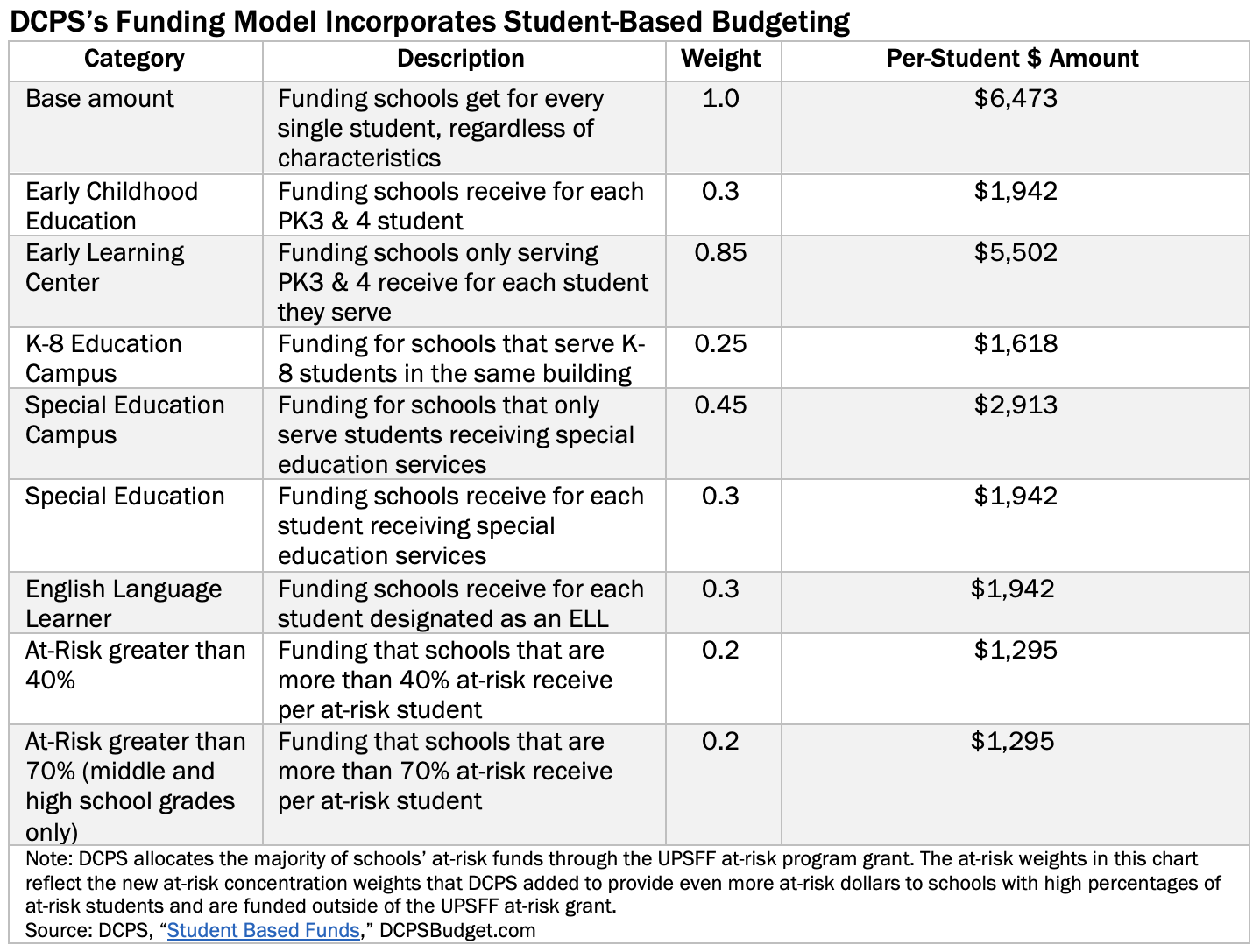
DCPS determines a school’s SBB funding by multiplying different weights by the base (like how the District multiplies different weights by the UPSFF foundation level). The amounts from this process are then multiplied by the number of students that meet the weight’s criteria to calculate the total SBB amount that DCPS allocates to a school for a particular weight. Figure 7 reflects a scenario of how DCPS would determine the SBB portion of a 600-student, K-8 school’s budget.
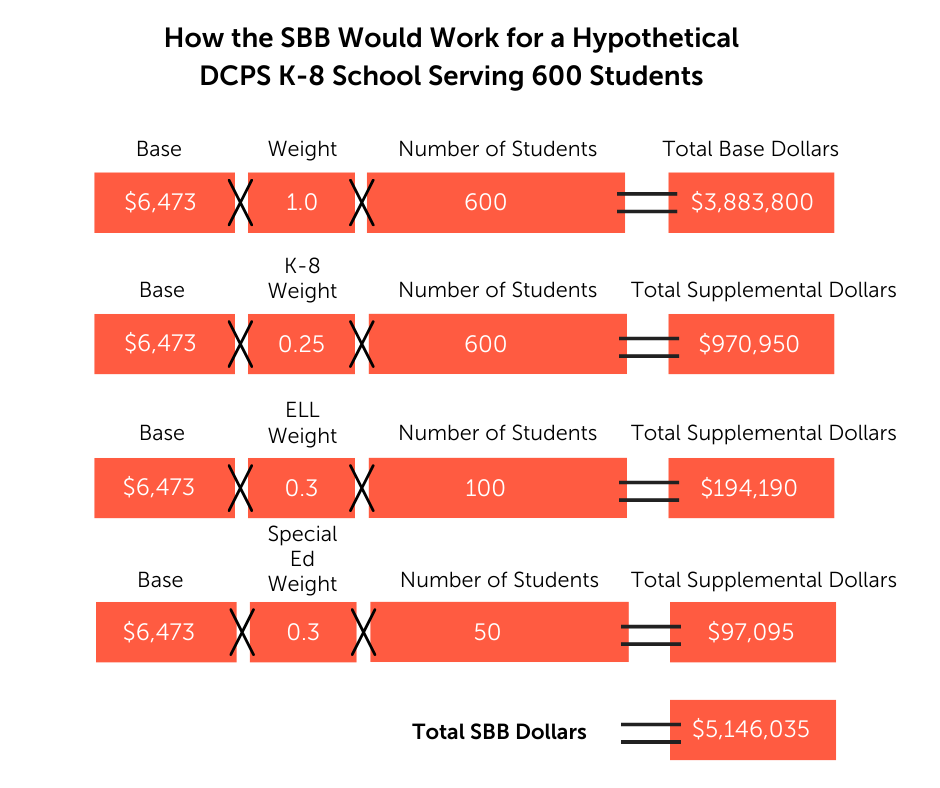
The Budget Model Requires Schools to Fund Some Positions
The updated model mandates schools to employ certain positions at a specified staff-to-student ratio, known as staff-based allocations. This helps ensure that “essential services, such as special education and English language instruction,” are available at every school that needs these resources. Some allocations are for select schools, while DCPS provides a general mandate for staff-based allocations that applies to all schools (Table 3). Note that there are some exceptions to these allocations. Residents can read more about these exceptions on the DCPS budget website.
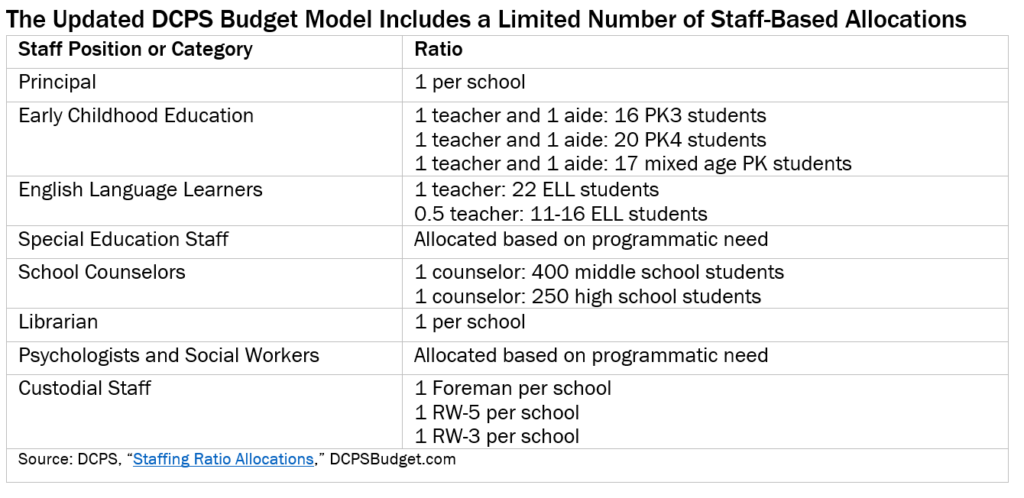
Targeted Supports Through Program Grants
DCPS allocates more funding to schools via program grants. Some of these grants go to all schools, such as for office support and UPSFF “at-risk” program. DCPS also provides grants to select schools, such as dual language or international baccalaureate schools. It also allocates federal Title I grants for which select schools are eligible.
Importantly, DCPS allocates most of an eligible school’s “at-risk” funding through the UPSFF “at-risk” program grant. Schools serving higher percentages of “at-risk” students receive additional funding outside of this grant via the SBB formula discussed above. By law, DCPS is required to allocate 90 percent of the “at-risk” funding it receives from the UPSFF directly to schools. Yet DCPS has regularly violated this law without consequence, shortchanging students from families with low incomes who are mostly Black and brown.
Stability Funding
To limit fluctuations in school budgets from year to year, DCPS provides additional stability funds. In FY 2024, DCPS provides three different types of stability funding. Two of the three types of stability funds are part of the new budget model and recurring while the other is a short-term response to the pandemic and its effects on enrollment and student needs.
- Stabilization funds (recurring): These funds ensure that schools receive no less than 95 percent of their prior year’s total funding, as mandated by law. DCPS has not always followed the law.
- Safety net funds (recurring): These funds ensure that schools with insufficient enrollment-based funds can still provide a baseline of services or positions (namely those in the staff-based allocation).
- Mayor’s Pandemic Recovery Funds (short-term): These funds ensured that in SY 2023-24, schools’ initial budget allocations were stabilized to at least 95 percent of their previous year’s funding level. This is the second year that the mayor has committed these recovery dollars to DCPS.
Residents can view individual school budgets on the DCPS budget website. DCPS provides school budget worksheets and has a data visualization tool that residents can use to learn more about how DCPS allocates funding to schools through the operating budget.
DCPS Facilities Are Funded through DC’s Capital Budget
DCPS school facilities are not funded through the UPSFF. New school construction and modernizations, or renovations, are funded through DC’s six-year Capital Improvement Plan (CIP). In addition, the District relies on a Public Education Master Facilities Plan to manage the timeline of the modernization of DCPS facilities, and it is meant to influence the planning and funding of capital projects in the CIP. In 2023, the DME’s office hosted several several public town halls as a part of the Master Facilities Plan to elicit feedback from families, school staff, and community members.
The District owns and controls all DCPS school buildings. The Department of General Services manages major repairs and renovations for DCPS school buildings. Maintenance services include functions such as maintaining cooling and heating systems, roof repair, plumbing repair, and other work to keep school buildings safe for students.
How Public Charter LEAs Fund Their Schools
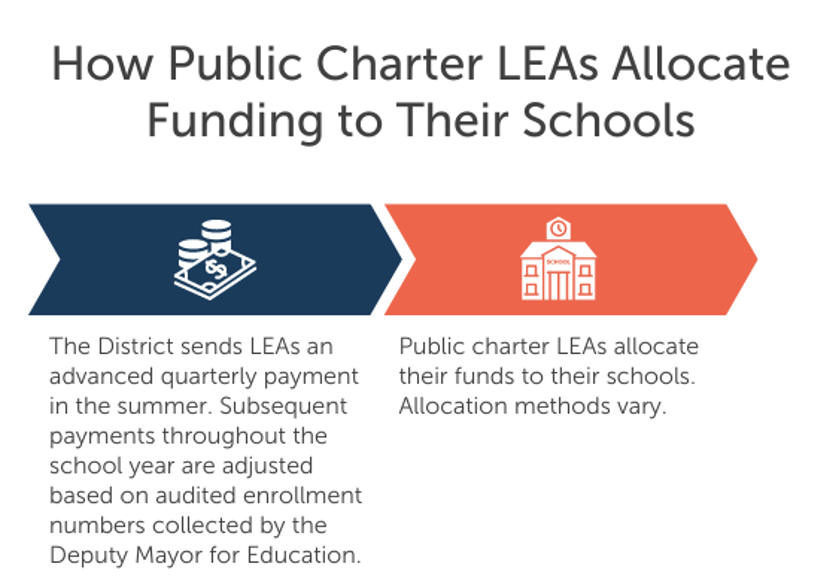
DC’s 69 public charter LEAs—independent, non-profit organizations that serve students across 136 school campuses—have an entirely different funding model than DCPS. Each LEA has the authority to allocate its UPSFF funding to its schools in the manner it chooses. There is no uniform funding formula that determines individual public charter school budget allocations. And while the DC Public Charter School Board (PCSB) is responsible for overseeing public charter LEAs, it does not have any budgetary authority over the LEAs’ local, federal, or private funding.
Public charter LEAs are funded based on their audited, or actual, enrollment. The DME works with LEAs to project their enrollment for an upcoming school year. Unlike with DCPS, public charter LEAs do not receive one large lump sum of UPSFF funds. The District makes quarterly payments to each LEA and those payments are adjusted up or down based on each LEA’s audited enrollment. LEAs receive an advanced payment in July, while the remaining payments are made in October, January, and April (Figure 8).
DC residents can learn more about public charter school budgets and other financial matters through the PCSB’s “Transparency Hub.” Note that public charter LEAs have not been historically subjected to the same data transparency laws as DCPS and other government agencies. However, improvements to transparency are on the horizon. In 2024, the District will publish reports on DCPS and public charter LEA finances using common reporting metrics. This should help policymakers and DC residents better grasp how both sectors compare in leveraging billions of public dollars to educate DC students.
 Use Your Voice to Influence Public Charters’ Budget Process!
Use Your Voice to Influence Public Charters’ Budget Process!
- Talk with your school’s leadership team about budget issues.
- Testify about budget needs at PCSB meetings.
- Request meetings with Councilmembers or their staff.
- Organize walkarounds at the John A. Wilson Building.
- Testify about budget needs at DC Council hearings.
- Flag concerns at relevant DC State Board of Education hearings.
Public Charter LEAs Finance Their Own Facilities
Public charter LEAs are responsible for purchasing their own facilities. They are also responsible for paying for maintenance or renovations. Some LEAs lease buildings from DCPS, but most purchase or lease facilities through the private market. The District provides some financial support to LEAs via a per-student facility allowance included in the UPSFF. This allowance is based roughly on how much the District spends per student on DCPS’s capital costs. Additionally, the Office of Public Charter School Financing and Support helps LEAs leverage their facilities allowance to secure additional capital financing support through the private market and other financing resources. The office also helps LEAs finance the capital costs of renovating former DCPS facilities and commercial buildings that LEAs occupy.
Appendix A. Relevant Public Education Agencies in DC
Office of the State Superintendent of Education (OSSE): OSSE is DC’s state education agency and the District’s liaison to the U.S. Department of Education. OSSE oversees all federal education programs and related grants administered in the District.
DC Public Charter School Board (DC PCSB): DC PCSB is the sole authorizer of the District’s public charter schools and is responsible for conducting oversight of all public charter operators and schools.
District of Columbia Public Schools (DCPS): DCPS is the largest LEA in the District and operates all the traditional public schools. DCPS is the “school system of right,” meaning all students in DC have the right to attend their DCPS neighborhood school and the system must serve all eligible students who seek admission.
Public Charter Schools: Public charter schools are funded publicly but operated independently. Public charter schools are free and open to all DC students. Each charter school operator is a non-profit corporation run by its own Board of Trustees and is considered an LEA under federal guidelines.
DC State Board of Education: The State Board of Education is responsible for advising the State Superintendent of Education on educational matters, including standards and policies governing special, academic, vocational, charter and other schools; state objectives; and state regulations proposed by the mayor or the State Superintendent of Education. The State Board is also responsible for approving state-level policies such as: state academic standards, high school graduation requirements, standards for high school equivalence credentials, and more.
Appendix B. School Finance Resources
DC Public School Budgets: Visit this website to learn more about DCPS’ school budget model and to view individual school worksheets.
DC Public Charter School Board Transparency Hub: Visit this website public charter school budgets, financial audits, at-risk spending plans, and more.
OSSE LEA ESSER Dashboard: Visit this website to see how LEAs have allocated and spent their ESSER funds.
Office of the Chief Financial Officer Annual Budget Documents: Visit this website to view current and past operating and capital budgets for DCPS, public charter LEAs, and other relevant education agencies in the District.
Appendix C. Glossary
Adequacy: An approach to school funding based on the idea that the amount of funding schools receive should be based on some estimate of the cost of achieving the state’s educational goals.
Budget: The total amount of money available principals with input from local school advisory teams (LSATs.)
Capital projects: Investments in buildings and infrastructure. These are usually funded through a bond or other one-time funds and budgeted for separately from operating costs.
Central Office: Oversees the DCPS system, including operational tasks such as human resources and procurement, and school supports that are budgeted outside of individual school budgets, including food service and substitute teachers.
Charter school: A public school that is managed by a nonprofit under agreements approved by the DC Public Charter School Board and that commits to achieving specific educational objectives. Similar to DCPS’s citywide schools, DC residents can apply to public charters through a lottery system. However, charters do not operate any by-right neighborhood schools in the District.
English Language Learners (ELL): Students for whom English is not their native language. These students typically require supplementary English as a Second Language (ESL) certified support staff and are required to take additional ESL assessments.
Enrollment: The total number of students.
ESSER I, II, and III: ESSER I and II grants were primarily for preventing, preparing for, and responding to COVID-19. This included hiring new staff and avoiding layoffs. ESSER III funds had similar allowable purposes; the US Department of Education also encouraged local education agencies to use ESSER III grants to fund the safe reopening of schools.
Set-aside: Ten percent of ESSER I-IIIthat do not go directly DCPS or charters but are instead left for the state agency (OSSE) to provide supplemental services to Local Education Agencies.
Fiscal cliff: A sudden drop in school resources available to pay for planned spending when a funding source ends with no immediate replacement.
Fiscal year (FY): The annual period for an operating budget. In DC, the fiscal year begins October 1 and ends September 30—the same fiscal year followed by the federal government. Most states, including Maryland and Virginia, begin their fiscal years on July 1.
Initial budget: Original allocation a DCPS school receives and spending plan based on its projected enrollment and staff projections.
Intra-district funds: Payments for services provided by one District agency on behalf of another District agency.
Local Education Agencies (LEAs): An organization that operates publicly funded schools, included DC Public Schools (DCPS) and more than 60 charter organizations.
Local School Advisory Teams (LSAT): Groups of elected and appointed members that advise the principal on school improvement plans, budget proposals, and other important matters.
Operating budget: Fundspay for day-to-day expenses.
“School system of right:” In DC, this term refers to DCPS, the system in which every student has a guaranteed spot in their neighborhood school.
Schools First in Budgeting Amendment Act of 2021: Legislation approved by DC Council in 2022 that aims to stabilize individual school budgets from year-to-year.
Special Education: Programming that serves students with mental, physical, emotional, and behavioral disabilities. The major law governing special education is the federal Individuals with Disabilities Education Act, which guarantees a “free appropriate public education” to children with disabilities and mandates that, to the “maximum extent appropriate,” they be educated with their nondisabled peers in the “least restrictive environment.”
Submitted : The updated budget for a DC public school that is a part of the mayor’s overall budget submitted to the DC Council. The submitted budget is based on the initial allocation as well as engagement and feedback from LSATs, educators, and families; however, the mayor does not have to accept the feedback.
This was originally published on February 13, 2023, and was most recently updated on February 6, 2024.

